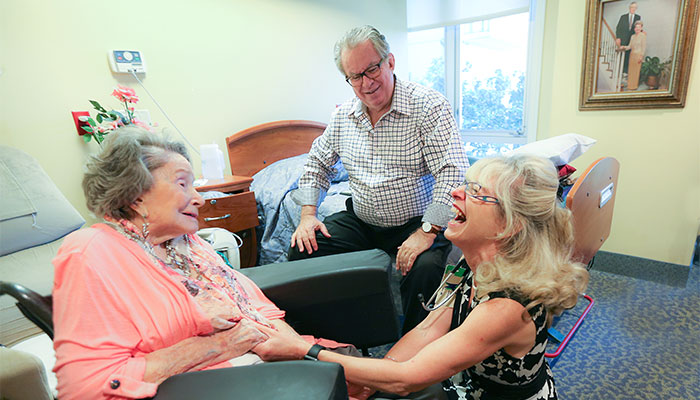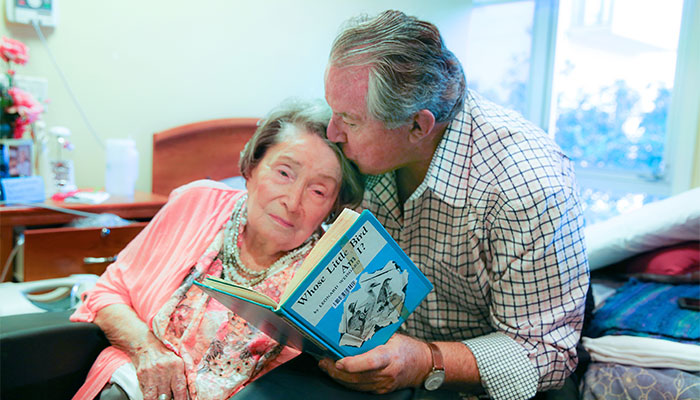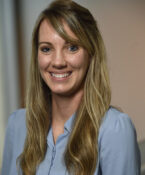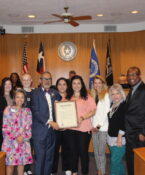The multi-generational geriatrician
By Jan Jarvis

At a glanceThe trendAmericans are living longer. The average life expectancy in the United States is now 78. The needBy 2030, about 30,000 geriatricians will be needed to care for 21 million older Americans. It is projected that 30 percent of the 65-plus population will need to be cared for by a geriatrician. The valueGeriatricians are trained to consider the unique medical needs of older patients. They take into consideration the medications, lifestyle and other factors that keep older patients healthy and active. |
Decades have passed since Robina Drakeford first called her son “Little Bird,” a nickname borrowed from a prized childhood book. Now 100 years old, she still whispers the name when her son Warwick Drakeford sits down beside her.
Such exchanges are still common between the centenarian mother and her son, who, with a friendly wink, declines to provide his true age. Both are under the care of geriatrician Janice Knebl, DO, Director of the Center for Geriatrics at UNT Health Science Center.
That puts mother and son on the leading edge of a health care trend. With the average life expectancy for Americans now up to 78 years, it’s becoming more common for multiple generations of the same family to be cared for by the same geriatrician. Dr. Knebl estimates she sees 10 multi-generational families, once unthinkable when she started her practice three decades ago.
“It’s the way of the future,” said Dr. Knebl, who holds the Dallas Southwest Osteopathic Physicians Inc. Endowed Chair of Clinical Geriatrics. “There may come a day when geriatricians will be treating three generations of a family at the same time.”
In the next 15 years, the demand for physicians trained to care for the special needs of older adults is expected to explode. By 2030, roughly 30,000 geriatricians will be needed to care for 21 million older Americans, according to the American Geriatric Society. It is projected that 30 percent of the 65-plus population will need to be cared for by a geriatrician and that each geriatrician can care for 700 older adults.
Given there are only about 7,000 certified geriatricians, at least 1,500 physicians would need to specialize in this area of medicine for each of the next 15 years to meet demand. In Texas, there are 373 certified geriatricians with 2,200 more needed by 2030.
Dr. Knebl said she never imagined she would be treating multiple generations at the same time. But over the years it has become more common to treat two generations – and treating three simultaneously is on the horizon. Today it is possible for the first generation to be in their 100s, the second in their 80s and the third in their 60s, she said.
“We won’t accept patients until they are 65,” Dr. Knebl said. “But we have a lot of children who get to know us while we’re taking care of their parents, and they can hardly wait to start seeing us as soon as they turn 65.”
Dr. Knebl has long recognized the importance of focusing on the complex health issues of older adults. She directs the Seniors Assisting Geriatric Education or SAGE Program, which connects future health care professionals training at the Health Science Center with older citizens in the community.
In the interprofessional SAGE program, teams of UNTHSC students training to become physicians, pharmacists, physical therapists and physician assistants, along with nursing students from Texas Christian University, make house calls to elderly citizens in Fort Worth. The students provide basic health and wellness checks and perform assessments of fall risks in the home, while being exposed to the complexities of geriatrics care and learning to improve their bedside manner.
Dr. Knebl also is the principal investigator on a federally funded project in Tarrant County called WE HAIL, or Workforce Enhancement Healthy Aging and Independent Living. In collaboration with JPS Health Network, TCU and the United Way’s Area Agency on Aging of Tarrant County, the project seeks to transform geriatric care in North Texas by improving medical care and health care delivery to older residents.

Geriatricians are critical because they are able to take into consideration medications, lifestyle and other factors to help older adults stay healthy, Warwick Drakeford said.
“Other doctors could do it, but I think it’s better done in a setting where every patient is elderly,” he said.
For the Drakefords, being treated by a geriatrician has become a family tradition they hope to carry on for generations. And in Dr. Knebl, the family found a geriatrician who understands the unique medical needs of older adults.
“My father saw her until he died at age 90,” Warwick Drakeford said. “My mother also sees her. I see her. And when my daughter gets to 65, I hope she does, too.”
His mother, who was born in Ireland, is a petite, active woman who never gained weight and stayed in shape. She never smoked, drank or stayed up late, and she played tennis until she was 84, he said. When she turned 100 in May, she celebrated with a party and received autographed birthday cards from four U.S. presidents.
Warwick Drakeford’s father, John, was an Australian who served in World War II as a chaplain with his country’s army in New Guinea. The couple moved to Fort Worth in the 1950s, where he eventually became a professor emeritus at Southwestern Baptist Theological Seminary. He earned six degrees, including two doctorates, and wrote more than 40 books, his son said.
Seeing how Dr. Knebl treated his parents deepened the bond his family has with her, Warwick Drake said. It helps too that she knows firsthand about his family’s medical history and has an understanding of their health concerns.
“How often does a doctor really personally know your whole family history across generations?” he said. “It creates a closer tie in the physician-patient relationship. It’s just a wonderful thing for the whole family.”




Social media